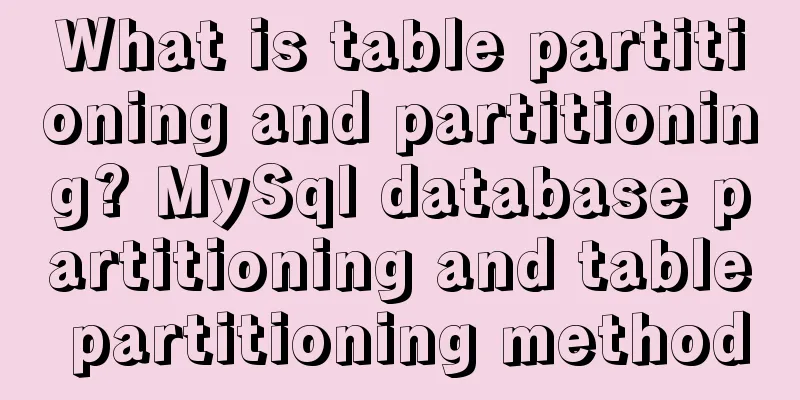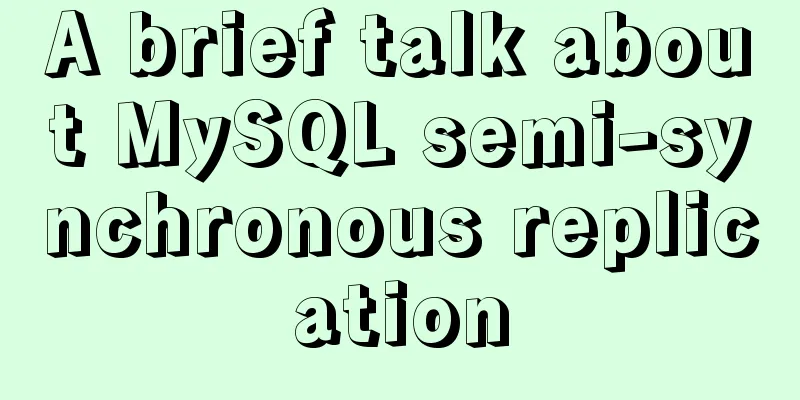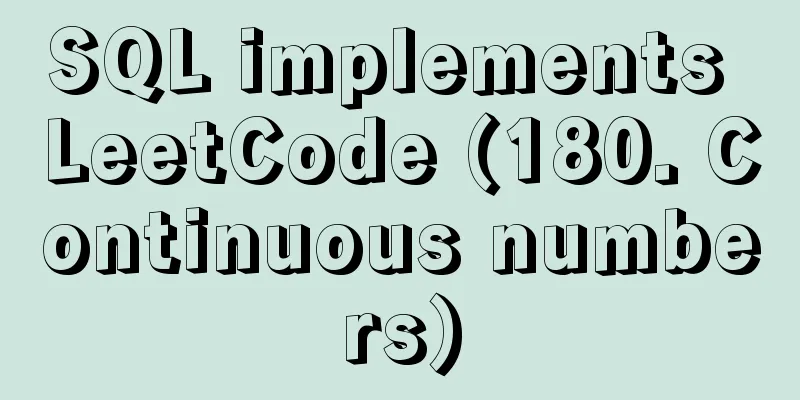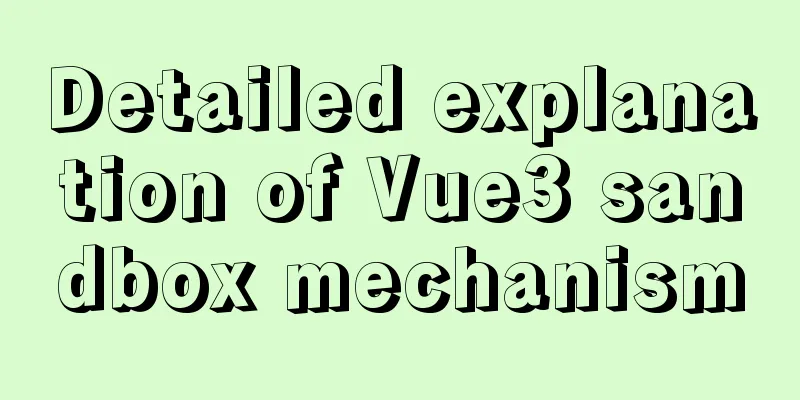What is table partitioning and partitioning? MySql database partitioning and table partitioning method

|
1. Why do we need to divide tables and partitions? In daily development, we often encounter large tables. The so-called large tables refer to tables that store millions or even tens of millions of records. Such a table is too large, causing the database to take too long to query and insert, resulting in poor performance. If a joint query is involved, the performance will be even worse. The purpose of table sharding and table partitioning is to reduce the burden on the database and improve the efficiency of the database. Generally speaking, it is to improve the efficiency of adding, deleting, modifying and checking tables. 2. What are table sharding and partitioning? 2.1 Sub-table Table sharding is to decompose a large table into multiple entity tables with independent storage space according to certain rules. We can call them sub-tables. Each table corresponds to three files: MYD data file, .MYI index file, and .frm table structure file. These subtables can be distributed on the same disk or on different machines. When the app reads and writes, it obtains the corresponding subtable name according to the pre-defined rules and then operates it. 2.2 Partitioning Partitioning is similar to table sharding, both of which decompose tables according to rules. The difference is that table sharding breaks down a large table into several independent physical tables, while partitioning divides data into segments and stores them in multiple locations, which can be the same disk or on different machines. After partitioning, it is still a table on the surface, but the data is hashed to multiple locations. When the app reads and writes, it still operates on the big table name, and the db automatically organizes the partitioned data. 2.3 What is the connection between MySQL table sharding and partitioning? 1) Both can improve the performance of MySQL and have a good performance under high concurrency conditions. 3. Several ways to divide the table 3.1 MySQL Cluster It is not a sub-table, but it plays the same role as a sub-table. The cluster can share the number of database operations and distribute the tasks to multiple databases. The cluster can separate read and write to reduce read and write pressure. This improves database performance. 3.2 Custom rule table Large tables can be decomposed into multiple sub-tables according to business rules. Usually there are the following types, but you can also define your own rules. Range – This mode allows you to divide your data into different ranges. For example, a table can be divided into several partitions by year. The table splitting rules are the same as the partitioning rules and are introduced in detail in the partitioning module. The following is a brief introduction on how to divide the table (by year) using Range. Assume that the table structure has 4 fields: auto-increment id, name, deposit amount, deposit date. Use the deposit date as a rule to split the table and create several tables separately.
var getTableName = function() {
var data = {
name: 'tom',
money: 2800.00,
date: '201410013059'
};
var tablename = 'account_';
var year = parseInt(data.date.substring(0, 4));
if (year < 2012) {
tablename += 2011; // account_2011
} else if (year < 2013) {
tablename += 2012; // account_2012
} else if (year < 2014) {
tablename += 2013; // account_2013
} else if (year < 2015) {
tablename += 2014; // account_2014
} else {
tablename += 2015; // account_2015
}
return tablename;
}
3.3 Using the merge storage engine to implement table sharding The merge table is divided into a main table and a sub-table. The main table is like a shell, which logically encapsulates the sub-table. In fact, all data is stored in the sub-table. We can insert and query data through the main table. If we know the rules of sub-tables, we can also directly operate the sub-tables. Subtable 2011 CREATE TABLE `account_2011` ( `id` int(11) NOT NULL AUTO_INCREMENT , `name` varchar(50) CHARACTER SET utf8 COLLATE utf8_general_ci NULL DEFAULT NULL , `money` float NOT NULL , `tradeDate` datetime NOT NULL PRIMARY KEY (`id`) ) ENGINE=MyISAM DEFAULT CHARACTER SET=utf8 COLLATE=utf8_general_ci AUTO_INCREMENT=2 CHECKSUM=0 ROW_FORMAT=DYNAMIC DELAY_KEY_WRITE=0 ; Subtable 2012 CREATE TABLE `account_2012` ( `id` int(11) NOT NULL AUTO_INCREMENT , `name` varchar(50) CHARACTER SET utf8 COLLATE utf8_general_ci NULL DEFAULT NULL , `money` float NOT NULL , `tradeDate` datetime NOT NULL PRIMARY KEY (`id`) ) ENGINE=MyISAM DEFAULT CHARACTER SET=utf8 COLLATE=utf8_general_ci AUTO_INCREMENT=2 CHECKSUM=0 ROW_FORMAT=DYNAMIC DELAY_KEY_WRITE=0 ; Main table, all years CREATE TABLE `account_all` ( `id` int(11) NOT NULL AUTO_INCREMENT , `name` varchar(50) CHARACTER SET utf8 COLLATE utf8_general_ci NULL DEFAULT NULL , `money` float NOT NULL , `tradeDate` datetime NOT NULL PRIMARY KEY (`id`) ) ENGINE=MRG_MYISAM DEFAULT CHARACTER SET=utf8 COLLATE=utf8_general_ci UNION = (`account_2011`,`account_2012`) INSERT_METHOD=LAST ROW_FORMAT=DYNAMIC ; When creating the main table, there is an INSERT_METHOD that specifies the insertion method. The values can be: 0: no insertion allowed; FIRST: insert into the first table in the UNION; LAST: insert into the last table in the UNION. When querying through the main table, it is equivalent to querying all the sub-tables together. This does not reflect the advantages of sub-tables. It is recommended to query sub-tables. 4. Several ways of partitioning 4.1 Range create table range( id int(11), money int(11) unsigned not null, date datetime )partition by range(year(date))( partition p2007 values less than (2008), partition p2008 values less than (2009), partition p2009 values less than (2010) partition p2010 values less than maxvalue ); 4.2 List create table list( a int(11), b int(11) )(partition by list (b) partition p0 values in (1,3,5,7,9), partition p1 values in (2,4,6,8,0) ); 4.3 Hash create table hash( a int(11), b datetime )partition by hash (YEAR(b) partitions 4; 4.4 key create table t_key( a int(11), b datetime) partition by key (b) partitions 4; 4.5 Partition Management 4.5.1 Adding a new partition ALTER TABLE sale_data ADD PARTITION (PARTITION p201010 VALUES LESS THAN (201011)); 4.5.2 Deleting a Partition When a partition is deleted, all data in the partition is also deleted. ALTER TABLE sale_data DROP PARTITION p201010; 4.5.3 Merge Partitions The following SQL merges p201001 - p201009 into 3 partitions p2010Q1 - p2010Q3 ALTER TABLE sale_data REORGANIZE PARTITION p201001,p201002,p201003, p201004,p201005,p201006, p201007, p201008, p201009 INTO ( PARTITION p2010Q1 VALUES LESS THAN (201004), PARTITION p2010Q2 VALUES LESS THAN (201007), PARTITION p2010Q3 VALUES LESS THAN (201010) ); The above is the full content of this article. I hope it will be helpful for everyone’s study. I also hope that everyone will support 123WORDPRESS.COM. You may also be interested in:
|
<<: Five ways to implement inheritance in js
>>: How to modify port 3389 of Windows server 2008 R2 remote desktop
Recommend
How to install MySQL under Linux (yum and source code compilation)
Here are two ways to install MySQL under Linux: y...
A brief discussion on how to elegantly delete large tables in MySQL
Table of contents 1. Truncate operation 1.1 What ...
In-depth understanding of MySQL master-slave replication thread state transition
Preface The basic principle of MySQL master-slave...
CSS3 flexible box flex to achieve three-column layout
As the title says: The height is known, the width...
Detailed explanation of how to use the calendar plugin implemented in Vue.js
The function to be implemented today is the follo...
Example code for implementing an Upload component using Vue3
Table of contents General upload component develo...
Implementation script for scheduled database backup in Linux
Table of contents Scenario: The server database n...
Mini Program to Implement the Complete Shopping Cart
The mini program implements a complete shopping c...
Implementing login page based on layui
This article example shares the specific code of ...
Summary of the main attributes of the body tag
bgcolor="text color" background="ba...
MySQL Practical Experience of Using Insert Statement
Table of contents 1. Several syntaxes of Insert 1...
How to install common components (mysql, redis) in Docker
Docker installs mysql docker search mysql Search ...
How to install MySQL server community version MySQL 5.7.22 winx64 in win10
Download: http://dev.mysql.com/downloads/mysql/ U...
Recommend a cool flashing alarm button
The effect is as follows: The code is as follows ...
vue3.0+echarts realizes three-dimensional column chart
Preface: Vue3.0 implements echarts three-dimensio...









